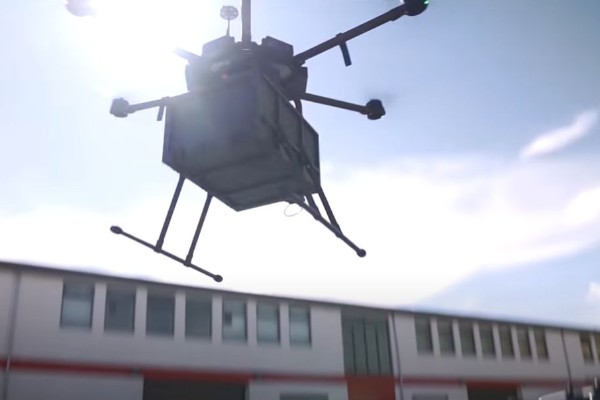Drones are controlled by internet, requiring nobody to manually fly them.
By Sharon Wrobel, The Algemeiner
An Israeli engineer who set out to land an unmanned spaceship on the moon is now seeking to spearhead aerial drone deliveries of food and other goods to American suburbs.
Yariv Bash is the co-founder of SpaceIL — a non-profit that is on course to make its second attempt at an unmanned moon landing in 2024 — and CEO of drone delivery startup Flytrex.
Back in 2013, Bash and his then roommate Amit Regev co-founded Flytrex to develop black boxes for consumer drones for real-time data tracking, before realizing in 2016 that the “killer application for drones is going to be drone delivery.”
“We are focusing on short range, high volume, and ultra-affordable drone deliveries to suburbs — that’s what we do. We have been delivering eggs, hot coffee, hot sandwiches, ice cream, and it works,” Bash told The Algemeiner in an interview on Sunday. “I like to call it the future of instant gratification. You can stay home and get that item delivered to you for the same price as in the store without any additional fee. So why bother getting out of your house to get it?”
In September 2020, Walmart launched a pilot to use the startup’s fully automated drones for backyard delivery of select grocery and household essential items from their stores around Fayetteville, North Carolina. This June, the restaurant chain El Pollo Loco began testing the door-to-backyard drone delivery in Southern California.
Bash explained that the drones are controlled through the internet, and don’t require anyone to fly them or drop the packages off at delivery in the backyard.
“There is no joystick. There is no video camera. All you have to do is install the app on your phone, choose your products, and press the order button. We can perform 10 to 15 deliveries per hour using multiple drones,” Bash said.
Flytrex drones can carry up to 6.6 lbs, he added. “Google’s drone delivery system can carry less than half the payload that we can, so it’s more about a coffee and a muffin and not the dinner for a family.”
The drones can fly at 32 mph for three miles, and are said to reach customers’ backyard within five minutes. Once the drone arrives at its destination, the delivery is gently lowered from an altitude of 80 feet using a wire-release mechanism.
The goal, Bash added, is not to charge the customer any additional delivery or service fees. “For the customer it is as affordable as going to the store, minus the time and money it costs you to get to the store,” he noted. “For the restaurant, it costs much less than the up to 30 percent they would pay Uber or Wolt today.”
For now, Flytrex’s pilot fleet stations are set up mainly in shopping malls, where they have runners who pick up orders from restaurants and place them in a box attached to the delivery drone.
“We are working on a future version to remove the runners as well, so that the drone will be outside the restaurant” and loaded by employees, Bash said.
In 2017, Flytrex launched the world’s first fully autonomous urban drone delivery system in Reykjavik, Iceland. One year later, the startup was accepted by the Federal Aviation Administration (FAA), the United States aviation authority, to a pilot program.
In North Carolina, Flytrex has three drone stations operating dozens of deliveries a day for food orders from restaurants and retail chains at the Holly Springs Towne Center. The volume of Flytrex orders across its North Carolina operations has increased more than tenfold since February, with thousands of deliveries to date, the startup reported last month.
Flytrex finds itself in good company in applying for airworthiness certification to expand its geographical reach in the US. Companies like Amazon and Alphabet’s Wing have received some regulatory approvals from the FAA, which allows them to participate in delivery via drone services with a limited number of pilots and drones.
“The same kind of certification which is done for airplane is adapted to unmanned vehicles. In the past four years, we have been busy with turning a drone into a commercial airplane and getting it certified by the FAA to allow us to perform deliveries all over the United States,” Bash said. “It means that we are going through the same regulatory hurdles and are being tested as if we are a commercial airplane like Boeing, which is very different from operating a regular consumer drone.”
“We are going to be one of the few first companies that will ever receive that certification, which we expect to get within the next six months,” he added. “Then what we want to do is to deliver whatever people need to the backyards in the US.”
Flytrex last month raised $40 million in a series C funding round — taking its total funding to date to $60 million — to forge additional partnerships with retail chains and fast-food restaurants for its US expansion.
Bash contended that a lot of the large restaurant chains and retailers are less inclined to work with the likes of Alphabet’s Google because they are concerned about privacy issues and data-sharing.
“I think that currently we have more commercial partners than Google,” Bash said. “For now, we are very much focused on the US, but in in a few years, Europe is also a very interesting market.”


